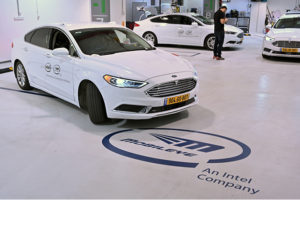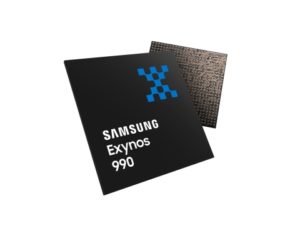
EDACafe Editorial Roberto Frazzoli
Roberto Frazzoli is a contributing editor to EDACafe. His interests as a technology journalist focus on the semiconductor ecosystem in all its aspects. Roberto started covering electronics in 1987. His weekly contribution to EDACafe started in early 2019. Mobileye’s growth; AI-enabled MCUs; 5G superchips; open source silicon; and more industry newsNovember 7th, 2019 by Roberto Frazzoli
Automotive and 5G are making news this week as usual, while a couple of updates involve the positioning technology landscape. A new class of devices joins the open source world, and MEMS productions continues to grow. Let’s take a look at these and other weekly news, including acquisitions and events updates. ADAS momentum drives Mobileye growth In the third quarter of 2019, Intel-owned Mobileye achieved a 20 percent revenue growth year over year driven by continued advanced driver-assistance systems (ADAS) momentum. By the end of 2019, Mobileye will have shipped more than 50 million EyeQ chips since 2008. Today, the company powers ADAS systems in 300 car models with 27 OEM partners. Mobileye has also announced a Level 4 design win with Chinese electric automaker NIO. Collaboration with NIO includes the development of a robotaxi vehicle, that will be exclusively sold to Mobileye for global deployment of robotaxi-based ride-sharing services. Infineon’s car MCUs to include Synopsys AI IP Infineon’s Next-generation Aurix automotive microcontrollers will integrate a new high-performance AI accelerator called Parallel Processing Unit (PPU) that will employ Synopsys’ DesignWare ARC EV Processor IP. Already today, the Aurix MCU supports certain types of neural networks; the new PPU, however, is expected to take its real-time and AI capabilities to an entirely new level. Samsung’s 5G superchips Samsung Electronics has recently introduced two impressive chips for future mobile devices that will make intensive use of video, artificial intelligence and 5G communications: the Exynos 990 mobile processor and the 5G Exynos Modem 5123, both manufactured in a 7nm process technology using EUV lithography. The Exynos 990 includes an embedded Arm Mali-G77 GPU, in addition to a tri-cluster CPU structure that consists of two custom cores, two Cortex-A76 cores and four Cortex-A55 cores. The Exynos 990 also includes a dual-core neural processing unit and DSP that can perform over ten-trillion operations (TOPs) per second. The 5G Exynos Modem 5123 supports virtually all mobile networks, from 5G’s sub-6GHz and mmWave spectrums to 2G GSM/CDMA, 3G WCDMA, TD-SCDMA, HSPA and 4G LTE. In 5G, with up to 8-carrier aggregation (8CA), the modem delivers a maximum downlink speed of up to 5.1-gigabits per second in sub-6-gigahertz and 7.35 Gbps in mmWave, or up to 3.0 Gbps in 4G networks by supporting higher-order 1024 Quadrature Amplitude Modulation. Virtualizing 5G radio access networks Nvidia and Ericsson are collaborating on technologies that can allow telco operators to build completely virtualized 5G radio access networks (RAN). Virtualized networks promise a faster and more flexible introduction of new AI and IoT services, such as augmented reality, virtual reality and gaming. The collaboration seeks to create a complete virtualized RAN solution that is comparable with traditionally built RAN networks in terms of cost, size and energy consumption. Silicon root of trust goes open source Google has recently announced the first open source silicon root of trust (RoT) project. Dubbed OpenTitan, it is expected to deliver a high-quality RoT design and integration guidelines for use in server motherboards, network cards, client devices (e.g., laptops, phones), consumer routers, IoT devices, and more. Silicon RoT can help ensure that the hardware infrastructure and the software that runs on it remain in their intended, trustworthy state by verifying that the critical system components boot securely using authorized and verifiable code. The project name comes from Google’s own custom-made RoT chip, Titan, used in Google’s data centers. The OpenTitan project is managed by the lowRISC CIC, a not-for-profit company based in Cambridge, UK, and is supported by a coalition that includes ETH Zurich, G+D Mobile Security, Google, Nuvoton Technology, and Western Digital. Growth of MEMS and sensors capacity continues According to a new report published by SEMI, total worldwide installed capacity for MEMS and sensors fabs is forecast to grow 25 percent to 4.7 million wafers per month (200mm equivalent capacity) from 2018 to 2023. Growth will be driven by explosive demand across communications, transportation, medical, mobile, industrial and other Internet of Things (IoT) applications. Positioning news A new positioning wireless company has been founded as a spin-off of Acorn Technologies. Called PHY Wireless (La Jolla, CA), it aims to be a pure-play provider of positioning mobile solutions for carriers, chip makers, IoT module manufacturers, application service providers and end users. PHY Wireless’s algorithms allow for positioning to be device-based with limited network interaction, thereby reducing power and extending battery life. Also in the positioning market, Locix (San Bruno, CA) has selected Imagination Technologies’ Ensigma IP for use in its Locix LPS solution, a Wi-Fi-based, local positioning system for indoor and outdoor environments. Ensigma is an IEEE 802.11ac 2×2 MIMO Wi-Fi baseband and RF IP. Acquisitions Rambus has recently completed the previously announced sale of its Payments and Ticketing businesses to Visa. Micron Technology has acquired the Artificial Intelligence startup FWDNXT (pronounced “forward next”) to explore deep learning solutions, particularly in IoT and edge computing. With this acquisition, Micron aims to offer a comprehensive AI development platform. Ansys has entered into a definitive agreement to acquire Dynardo, a provider of simulation process integration and design optimization (PIDO) technology. AVX Corporation has completed the purchase of Chengdu OK New Energy (COKNE), after four years of collaboration on the manufacturing and development of supercapacitors. Marvell has completed its acquisition of Avera Semiconductor, the ASIC business of Globalfoundries. And following the acquisition that took place last March, Integrated Device Technology (IDT) will change its 39-year old name into Renesas Electronics America. Founded in 1980, Integrated Device Technology is among the oldest Silicon Valleys’ chipmakers. Upcoming events The Collaborative Robots, Advanced Vision & AI (CRAV.ai) Conference will take place in San Jose, CA, November 12-13. The International Test Conference will open its doors in Washington, DC, November 12-14. Also starting on November 12, but continuing until 15, is Productronica (Munich, Germany), this year co-located with Semicon Europa. The Edge AI Summit will run on November 20 and 21 at the wonderful Computer History Museum in Mountain View, CA. |
|
|
|||||
|
|
|||||
|
|||||










